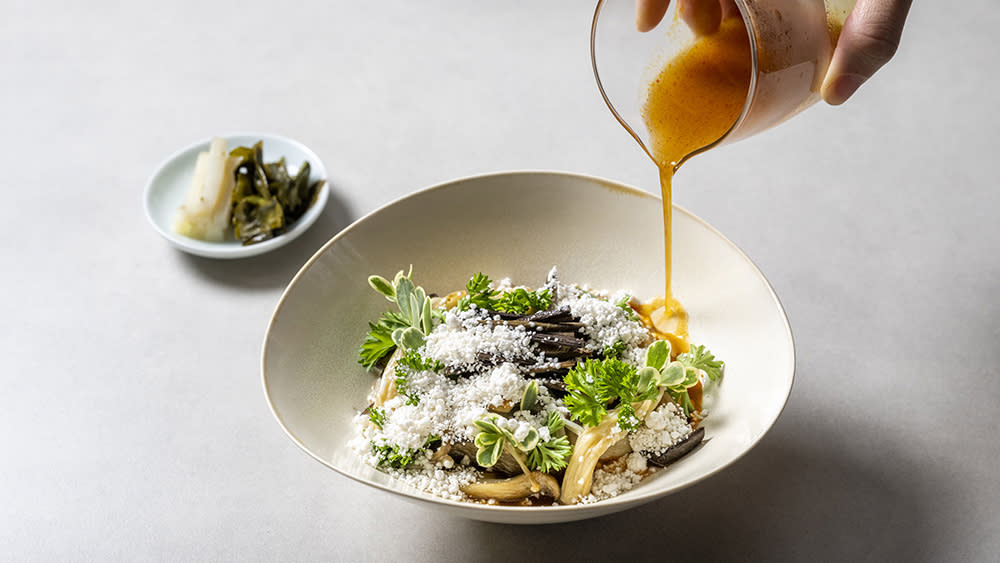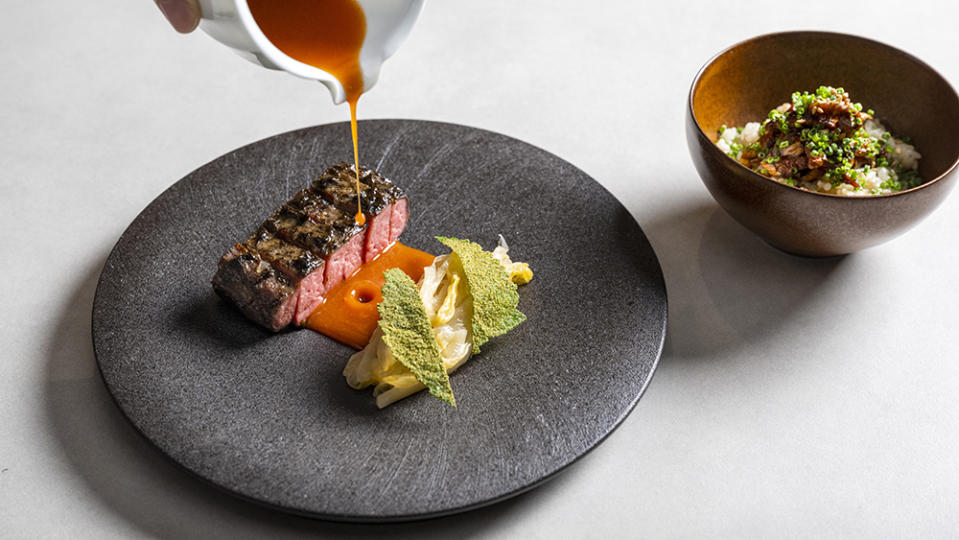NYC’s Rockefeller Center Is Rocking Again: A Guide to Eating Your Way Through the Rejuvenated Nabe

For as long as most New Yorkers can remember, dining at Rockefeller Center has been largely incidental. You were in the neighborhood and hungry—reconciled to eat at a lackluster restaurant golden-handcuffed to throngs of office workers and tourists. There were a few exceptions, sure, but none that truly spoke to the city’s potential.
But the iconic Art Deco complex is now in the throes of a culinary revitalization, and some of New York’s most important restaurant groups and chefs are planting their flag for the first time in Midtown. Developer Tishman Speyer started soliciting potential restaurants as early as 2019, focusing on home-grown New York talent. While the pandemic may have slowed down lease deals, according to insiders, it probably also convinced chefs to give Rock Center a shot.
More from Robb Report
From Millions to Trillions? 4 'Billions' Spin-Off Series Are in the Works, Showtime Says
Inside Bjarke Ingels's Stunning Pair of Twisting Condo Towers in New York City
This Wyoming Ranch Blends Luxury Lodging With Rugged Wild West Adventures
“One of the missions in this restaurant revival is to bring New Yorkers back to Rock Center,” says Junghyun Park, chef and co-owner of Atoboy, Atomix and, now, Naro. “In a way, we are rewriting Rockefeller Center’s history, and that in and of itself is a dream come true.”
In addition to Park, the revamp includes teams from notable restaurants including Estela, Frenchette, Olmsted and King. They’ve brought with them verve and vision, intricate tasting menus, bombastic pastas, polished cocktails and exceptional wine programs. After months of following the buzz and reacquainting ourselves with Rock Center, here’s how to do it best.
Lodi: Where You’ll Want to Linger Over Lunch

At Lodi, the all-day cafe from Ignacio Mattos and co., there’s counter service for pastries, coffee and take-home breads, but don’t rush out. And you should definitely book a dinner there. Really do. But lunch at Lodi, right off the Rockefeller Center plaza, is one of the city’s most charming. Sunlight pours onto the counter that rings the space, illuminating salumi slices like rosy stained glass windowpanes. Without a reservation, the counter’s where you’ll likely snag a seat and you’ll be happy for it.
Grab a porchetta sandwich, enhanced by the dual crunch of roasted pork skins and the house-made rustica bread. Better yet, order an Il Mediterraneo spritz or a glass of Etna Bianco and settle in for a few courses: chicken liver paté, anchovies with butter and whatever seasonal vegetable the kitchen has procured, a zippy chicory salad, or the involtino di cavolo, in which charred cabbage leaves are wrapped burrito-like around carnaroli rice and molten scamorza and then topped with truffles. Depending on the day (and meals) you have ahead, consider classic, delicate vitello tonnato or the red wine-braised hunk of brasato di manzo, a pot roast worthy of its address. And don’t leave without dessert, whether it’s the made-to-order fior di latte gelato or cookies from the pastry case.
Five Acres: Dinner With a on View

With three successful restaurants in Brooklyn, Greg Baxtom has finally arrived in Manhattan for, well, all the world to see. The dining room of his Five Acres, an ode to his family’s Illinois farm, is an open peninsula jutting out into the heart of the Rockefeller Center concourse. For breakfast, lunch, and dinner, tourists can see Baxtrom at the pass and your server pouring glasses of 100 percent Pinot Meunier Champagne; they stop to read Five Acres’ enlarged menu, as if they were strolling through Little Italy. Baxtrom’s given them a reason to gawk.
For starters, there’s the show-stopping smoked oysters Vanderbilt, topped with smoked crème fra?che, floral shiso oil and a dashi vinegar gelée, and served under a cloche from which smoked billows into the dining room. Tuna tartare reads staid these days, but Five Acres’ version is presented as a textural wreath of tuna, croutons, sprouts, pumpkin seeds and brunoise vegetables surrounding a pool of aji dulce sauce; mix and eat it with abandon. The crabcake, encrusted thick with panko and topped with bone marrow a?oli, feels delightfully landlocked. The restaurant’s sole pasta is not one at all. Instead, for its fettuccine alfredo, Baxtrom shaves kohlrabi, dresses it with an unholy amount of garlic cream, and accents it with little neck clams. For dessert, Olmsted’s famous froyo migrated across the river, as did s’mores, with cinnamon graham crackers stacked like logs, ready to dip in toasted marshmallow and chocolate cream.
Naro: A Deep Dive Into Traditional Korean Cooking

New York is awash with exceptional Korean food these days, thanks in no small part to Junghyun and Ellia Park, the husband-and-wife team behind Atoboy and Michelin two-star Atomix. Now with their rinkside Naro, the couple wants to introduce the city to more traditional Korean flavors via à la carte and tasting menu lunches, and its 10-course dinners. Start your meal with a glass of Brooklyn-made Hana Makgeolli Yakju 14, a soft, creamy, rice beverage with laser beam acid and notes of lemon-meringue pie—ideal with the flurry of opening snacks. Then dive into Sommelier Jhonel Faelnar’s wine list spanning esoteric, value-oriented Hungarian blends to premier cru Chablis and Burgundies.
The Park’s menus are a lesson in Korean food vocabulary, from its many jangs (ferments) to vegetable names and dishes like tangpyeongchae (aka mung bean jelly salad). Ask questions, submit not knowing exactly what you’re about to eat and trust that you will thrill at the texture of springy octopus and fresh kohlrabi lit up with mustard granita. For the twigim (Korean tempura) course, the kitchen encases brined fluke in a shrimp-napa cabbage farce, wraps it in kataifi dough, and fries the bundle, serving it all with songyi (matsutake) mushrooms and choganjang (a mixture of soy sauce and rice vinegar). The star of the oceanic bibimbap is sweet king crab, steamed and grilled over binchotan charcoal, with a basting of doenjang (miso) butter. And for dessert, the pastry team makes perfect, coconut cake-filled replicas of Oishii strawberries that they plate alongside an actual “omakase” berry.
Jupiter: You’re Here for Aperitivo and Pasta

Sipping the To-To, an aperitivo of Antica Torino amaro and extra dry Torino vermouth, is a sign: we’re not in the old Rock Center anymore. Yes, there are skaters just beyond the windows of Jupiter, the concourse-level restaurant from King’s Clare de Boer, Annie Shi and their new partner Jess Shadbolt. But they aren’t serving après-skate, Midtown Italian, at least in the traditional sense. There’s a push and pull here between refinement and fun, white tablecloths and bare-topped tables, Georg Jensen silverware and saucy bottarga pasta for twirling.
You’d also do well to start your meal with a fig leaf-accented vesper, premier cru Champagne, or a glass of anfora-aged Pecorino from Abruzzo; there’s no wrong answer if you’re ordering meaty fried artichoke hearts or a pile of zucchini fritti. Along with pretty radicchio, hazelnuts, quince, and herbs for pep, the insalata di stagione comes with rather forward hunks of Ubriaco cheese. The bruschetta is build-your-own with charred bread, a mound of crab, a?oli and bitter puntarelle. Jupiter’s playful streak comes out in a bowl of alphabet pasta in brodo, but the restaurant’s tajarin con fegato e prezzemolo—whole pieces of seared chicken liver atop tender, eggy pasta—is pure understated genius. At Jupiter, the pastas coming out of the long, rocking open kitchen seem to be the point. There are just two main courses: classic, crowd-pleasing grilled dorado (aka mahi mahi) with lemon, rosemary and anchovies, along with a porterhouse for two.
Le Rock: Downtown Energy in a Midtown Brasserie

With Le Rock, Lee Hanson and Riad Nasr got the best of Rock Center’s Art Deco grandiosity and glamour, and they’ve pumped it full of brasserie charm, Midtown bustle and Downtown energy. The bar, if you can secure a stool, is a fine place to drink a Chartreuse-laced Bijou Blanc cocktail, or perhaps an ode to the ubiquitous French seasoning, the Bouquet Garni, with white rum, génépy, lime, thyme and bay.
The dining room is elbow to elbow too, all banquets and densely packed tables in favor of isolated booths. You’ll overhear your neighbors’ conversations, and maybe trade ordering tips, simple acts that felt impossible a year ago.
New York is back, baby, so you might as well order a bottle of Champagne (or pét-nat for real Downtown cred) and a whole Dungeness crab, market price and dressed with horseradish-mustard mayonnaise, capers, grated egg and chives. There are other essential dishes at this new essential New York restaurant: garlic-y escargot topped with crunchy toasts and served in porcelain cups; a baguette with, your call, chicken liver mousse, crisp radishes and butter, or gussied up farmers cheese; snappy sausage studded with comté; lean bison au poivre smothered with green peppercorns; and French fries. Always order the French fries. And if you enjoyed your Chartreuse cocktail at the bar, ask your server to soak a slice of the towering baba cake with a slug of the liqueur. It’s potent stuff.
Pebble Bar: Your Rock Center Nitecap

A weeknight at Pebble Bar is a fascinating study in New York nightlife. First off, there’s a cocktail bar, a place you actually want to drink well-past happy hour, set above a Magnolia Cupcake on Sixth Avenue. It already sounds like a novel. Then you fill it with straight-from-their-office workers; women in floor-length gowns, presumably after an event at Rainbow Room; cool kids eating shrimp cocktail and drinking Monkey 47 Martinis; and sisters who are one drink away from catching the train back to New Jersey.
With its speakeasy history, power player ownership, and three floors of leather and low-light, Pebble Bar isn’t an everyman space by any stretch, but it’s found a rhythm hosting a cross-section of Midtown humanity. That and throwing launch events and swanky parties on its upper floors for the music, media and fashion crowds. Everyone else is coming for stirred and boozy drinks like the Night Train (rye, Ciocaro, Cynar, and bitters) and Lucille (mezcal, Montenegro, vermouth, mole bitters), amiable hospitality (the bartenders will split your Martini into two glasses if you need one more drink, but also need to share it), and that New York feeling that anything is possible.
Best of Robb Report
Why a Heritage Turkey Is the Best Thanksgiving Bird—and How to Get One
The 10 Best Wines to Pair With Steak, From Cabernet to Malbec
Sign up for Robb Report's Newsletter. For the latest news, follow us on Facebook, Twitter, and Instagram.
